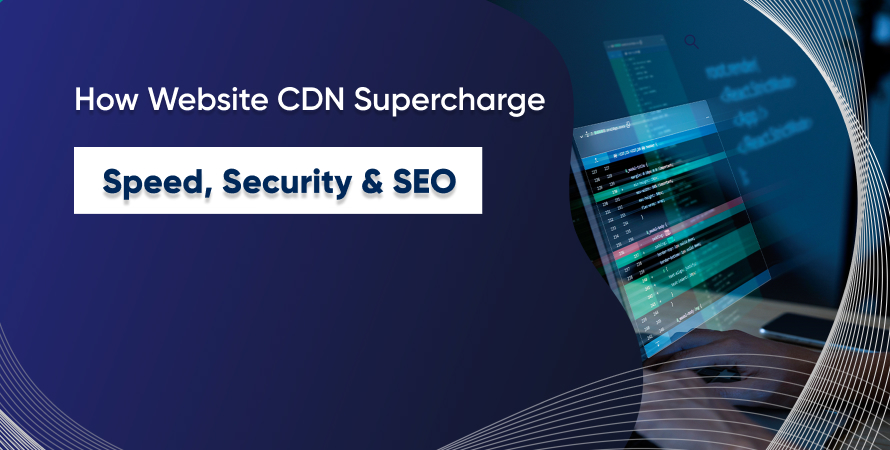How Website CDN Supercharge Speed, Security & SEO



When a user visits your website, they expect it to load fast, stay secure, and function without a hitch—regardless of where they are in the world. But how can a single server location meet the demands of a global audience? That’s where a CDN for website optimization becomes essential.
This blog will help you understand what a Content Delivery Network (CDN) is, how it works, and why it’s a fundamental tool if you’re looking to improve web performance, reduce latency, and strengthen SEO. Whether you’re a business owner, developer, or SEO specialist, mastering CDN usage can unlock major performance benefits.
Let’s dive into the core sections of how CDNs can transform your website’s performance, security, and search visibility.
What is a CDN?
A CDN (Content Delivery Network) is a distributed network of servers designed to deliver web content to users based on their geographic location. Instead of serving content from one central server, a CDN in networking works by storing cached versions of your site’s static files—such as HTML, CSS, JavaScript, and images—on multiple servers across the globe.
Imagine you’re hosting an eCommerce site based in New York, but you have customers in London, Sydney, and Tokyo. Without a CDN, every user request would travel all the way to your primary server in New York, causing high CDN latency and slower page loads. With a content delivery CDN, those same files are served from the nearest server, drastically speeding up the process.
This approach enhances CDN performance, reduces server load, and improves user experience by cutting down on load times.
How Does a CDN Work?
To understand how CDNs improve page speed, it’s important to know how they function behind the scenes.
CDNs operate through Points of Presence (PoPs)—these are strategically placed data centers across various geographic locations. Each PoP contains caching servers that store copies of your website’s static content. When a user accesses your website, the CDN automatically routes their request to the nearest PoP.
Here’s a breakdown of the process:
- A user visits your website.
- Their request is routed to the closest CDN server.
- The server delivers cached content in milliseconds.
- If the content isn’t cached, the CDN fetches it from the origin server and stores it for future use.
This reduces the time it takes for data to travel, which is crucial for enhancing CDN performance and optimizing Core Web Vitals like Total Blocking Time (TBT). For more technical insights, you can also check our guide on key facts about TBT.
By distributing content efficiently, CDNs also ensure redundancy and load balancing, which protects your website from crashes during sudden traffic spikes.
What Makes CDNs So Valuable for Website Improvement?
If your website takes more than a couple of seconds to load, you’re already losing traffic and potential revenue. Let’s explore why using a website CDN is a smart, future-proof decision:
Faster Load Times
A CDN improve page speed significantly by delivering assets from the nearest server, reducing the time it takes for pages to render. This enhances user satisfaction and engagement, especially on mobile.
Reliable Global Access
Since CDNs have a distributed network of servers, they ensure your content is available at optimal speeds no matter where your audience is located.
Security Enhancements
Many CDNs offer features like DDoS protection, SSL encryption, and secure token authentication. This helps maintain a secure environment while also keeping your site compliant with Google’s best practices.
Improved SEO
Google has made it clear that performance impacts rankings. A content delivery network SEO strategy helps improve Core Web Vitals, lowers bounce rates, and increases crawl efficiency—directly influencing your organic visibility.
For example, if you’ve been struggling with page with redirect errors, using a CDN can help streamline URL requests. Learn more about this in our detailed guide on resolving redirect errors in Search Console.
Who Should Use a CDN?
While CDNs are often associated with large corporations, the truth is that almost any website can benefit from a web CDN. Here’s a look at who should seriously consider implementation:
- E-commerce Stores: With a global customer base, fast and secure content delivery is essential.
- Bloggers and Publishers: Improve load times for international visitors, and keep bounce rates low.
- SaaS Platforms and Web Apps: Reduce latency and load times to ensure seamless user interactions.
- Media-Rich Websites: Handle large file delivery like images, videos, and audio efficiently.
No matter your website type, a well-integrated CDN can help resolve many common speed and performance bottlenecks. If you’re facing issues with Core Web Vitals or other technical SEO factors, our team at Hire Core Web Vitals Consultant can help. Explore our guide on fixing common Core Web Vitals issues in 2025 for more actionable insights.
Key Features to Look for in a CDN Provider
Not all content delivery network CDN providers are created equal. When evaluating options, you need to look beyond just speed. The right content delivery network services will offer a combination of performance, scalability, and security.
Here are essential features to consider:
- Global Server Presence: A wide-spread CDN delivery network ensures optimal speed for users across continents.
- Real-Time Analytics: Monitoring tools let you analyze traffic, security threats, and cache status.
- CMS Compatibility: Whether you’re on WordPress, Shopify, or a custom CMS, integration should be smooth.
- API Support: For advanced control and automation of cache rules, logs, and asset purging.
- Security Layers: Look for features like TLS/SSL, bot protection, and Web Application Firewall (WAF).
For those focusing on frontend optimization, pairing a CDN with proper resource hinting is ideal. Check out our blog on how to use preload, preconnect, and prefetch for faster content loads.
Top CDN Providers (2025 Snapshot)
To help you choose, here’s a quick look at some of the most reliable content distribution networks CDNs available today:
1. Cloudflare
- Strong free plan for small sites
- Built-in security features and caching rules
2. Akamai
- Pioneer in digital content delivery
- Highly reliable for enterprise-scale projects
3. Amazon CloudFront
- Seamless AWS integration
- Highly customizable for developers
4. Fastly
- Developer-friendly platform
- Great for real-time content updates
5. KeyCDN
- Affordable pricing
- Simple to set up for static websites
Each of these content delivery CDN providers has strengths depending on your specific goals—whether it’s security, cost, or performance.
Common Myths About CDNs
Understanding CDNs also means clearing up some long-standing misconceptions. Let’s set the record straight:
- Myth 1: Only big websites need a CDN
False. Even smaller blogs and local businesses benefit from improved CDN latency and speed. - Myth 2: A CDN is the same as a hosting service
Incorrect. A CDN doesn’t host your site—it distributes cached content for faster CDN delivery network responses. - Myth 3: CDNs are hard to set up
Many modern CDN platforms offer one-click setup for major CMSs. Paired with optimization tools, the process becomes seamless.
One area where many developers falter is web font optimization. Fonts are often overlooked but play a huge role in performance. Learn how to tackle this in our guide to optimize web fonts for better Core Web Vitals.
How to Implement a CDN on Your Website
Getting started with a CDN for website performance is easier than most people think. Here’s a simplified step-by-step approach:
- Choose a CDN Provider: Based on your site’s needs—global access, budget, security.
- Update DNS Settings: Point your domain to the CDN’s nameservers.
- Enable SSL: Many providers offer free SSL through Let’s Encrypt.
- Configure Caching Rules: Define what to cache and when to purge.
- Test & Monitor: Use tools like GTmetrix or PageSpeed Insights to assess the improvement.
Pairing a CDN with Core Web Vitals expertise can yield even stronger results. If you’re unsure how to move forward, our team at Hire Core Web Vitals Consultant offers personalized audits and guidance tailored to your site’s needs.
Potential Downsides and Considerations
While CDNs offer massive benefits, they’re not without limitations:
- Cost for Premium Features: Advanced security and analytics may incur higher pricing.
- Limited Impact for Local-Only Sites: If your audience is concentrated in one region, gains might be minimal.
- Caching Complexity: Poorly configured rules can result in outdated content or broken scripts.
Proper setup and ongoing monitoring are essential to avoid these issues. Consider a professional audit if you’re implementing CDNs for the first time.
Conclusion
A well-configured CDN can drastically improve web speed, user experience, and SEO rankings. Whether you’re managing a large eCommerce site or a growing content hub, using a CDN is no longer optional—it’s strategic.
If your goal is long-term performance and visibility, combining a content delivery network SEO approach with Core Web Vitals optimization is the way forward. Our consultants at Hire Core Web Vitals Consultant can help tailor a solution specific to your site and audience.
Frequently Asked Questions (FAQs)
Content delivery definition refers to the process of distributing web content (such as images, videos, scripts, and HTML files) from servers to end users efficiently and quickly. This is typically done through a Content Delivery Network (CDN), which reduces the physical distance between users and the content by using geographically distributed servers.
A Content Delivery Network CDN services significantly improve website speed, which is a core factor in Google’s ranking algorithm. Faster loading times reduce bounce rates, increase user engagement, and improve Core Web Vitals—making your site more favorable in search engine results.
Any website that targets users in multiple regions or relies heavily on media files can benefit from a CDN. Whether you’re a blog owner, SaaS developer, or eCommerce brand, a content delivery network provider can help you optimize load times, improve reliability, and enhance security—critical factors for user satisfaction and search visibility.
Yes and no. A CDN handles delivery content for static assets like images, stylesheets, fonts, and scripts. It can also cache dynamic content depending on configuration, but your origin server still handles personalized user data and backend operations.
Yes. Leading content delivery network CDN services are designed to work alongside existing web hosts and integrate easily with CMS platforms like WordPress, Joomla, and Drupal. They function as an additional performance layer rather than a replacement for your hosting.
When selecting a content delivery network provider, evaluate:
- Server distribution and global coverage
- Real-time monitoring tools
- Cost structure and scalability
- Security features like SSL, DDoS protection, and WAF
- Ease of integration with your existing tech stack